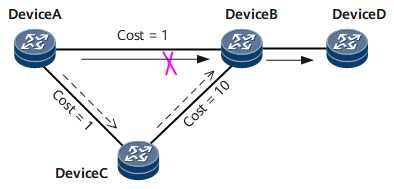BFD for RIP
Background
Routing Information Protocol (RIP)-capable devices monitor the neighbor status by exchanging Update packets periodically. During the period local devices detect link failures, carriers or users may lose a large number of packets. Bidirectional forwarding detection (BFD) for RIP can speed up fault detection and route convergence, which improves network reliability.
After BFD for RIP is configured on the router, BFD can detect a fault (if any) within milliseconds and notify the RIP module of the fault. The router then deletes the route that passes through the faulty link and switches traffic to a backup link. This process speeds up RIP convergence.
Table 1 describes the differences before and after BFD for RIP is configured.
Related Concepts
The BFD mechanism bidirectionally monitors data protocol connectivity over the link between two routers. After BFD is associated with a routing protocol, BFD can rapidly detect a fault (if any) and notify the protocol module of the fault, which speeds up route convergence and minimizes traffic loss.
-
In static BFD mode, BFD session parameters (including local and remote discriminators) must be configured, and requests must be delivered manually to establish BFD sessions.
Static BFD is applicable to networks on which only a few links require high reliability.
-
In dynamic BFD mode, the establishment of BFD sessions is triggered by routing protocols, and the local discriminator is dynamically allocated, whereas the remote discriminator is obtained from BFD packets sent by the neighbor.
When a new neighbor relationship is set up, a BFD session is established based on the neighbor and detection parameters, including source and destination IP addresses. When a fault occurs on the link, the routing protocol associated with BFD can detect the BFD session Down event. Traffic is switched to the backup link immediately, which minimizes data loss.
Dynamic BFD is applicable to networks that require high reliability.
Implementation
For details about BFD implementation, see "BFD" in Router Feature Description - Reliability. Figure 1 shows a typical network topology for BFD for RIP.
Dynamic BFD for RIP implementation:
RIP neighbor relationships are established among Device A, Device B, and Device C and between Device B and Device D.
Device A calculates routes, and the next hop along the route from Device A to Device D is Device B.
If a fault occurs on the link between Device A and Device B, BFD will rapidly detect the fault and report it to Device A. Device A then deletes the route whose next hop is Device B from the routing table.
Device A recalculates routes and selects a new path Device C → Device B → Device D.
After the link between Device A and Device B recovers, a new BFD session is established between the two routers. Device A then reselects an optimal link to forward packets.
Static BFD for RIP implementation:
RIP neighbor relationships are established among Device A, Device B, and Device C and between Device B and Device D.
Static BFD is configured on the interface that connects Device A to Device B.
If a fault occurs on the link between Device A and Device B, BFD will rapidly detect the fault and report it to Device A. Device A then deletes the route whose next hop is Device B from the routing table.
After the link between Device A and Device B recovers, a new BFD session is established between the two routers. Device A then reselects an optimal link to forward packets.
Usage Scenario
BFD for RIP is applicable to networks that require high reliability.
Benefits
BFD for RIP improves network reliability and enables devices to rapidly detect link faults, which speeds up route convergence on RIP networks.
